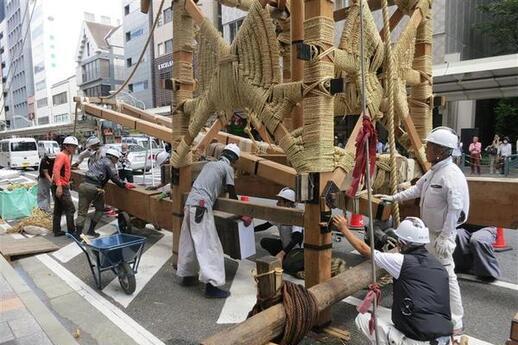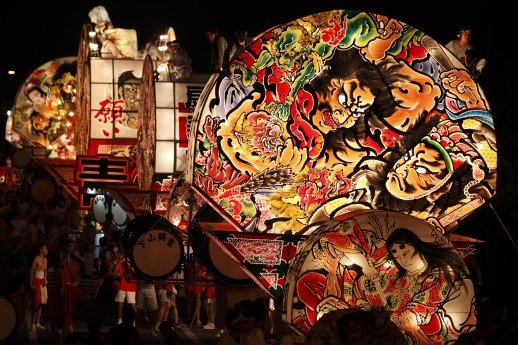2025.07.24
伝検通信(メルマガ)週刊メールマガジン「伝検通信」 第67号
週刊メールマガジン「伝検通信」第67号をお届けします。
今週のトップ記事では、京都の夏を彩る祇園祭にまつわる話題をお伝えします。
「クイズで肩慣らし」は、前回クイズの答え・解説と、「歳時記」の問題です。
第2回伝検は現在実施中で、こちらから申し込みを受け付けていま
伝検公式教材・参考書・サイト https://denken-test.jp/
目次
・ 暮らしに息づく伝統文化―京都の夏を彩る祇園祭―
・ 「クイズで肩慣らし」 第66回=「歳時記」
・ 伝検協会だより
暮らしに息づく伝統文化―京都の夏を彩る祇園祭―
岩楯達弥=時事通信ブランドスタジオ

「縄がらみ」と呼ばれる伝統技法で長刀鉾を組み立る手伝い方の人たち
夏の京都を彩る祇園祭。後半のハイライト、後祭(あとまつり)の山鉾(やまほこ)巡行が本日24日に執り行われると、幾つかの神事を経て祭りはフィナーレを迎えます。
祇園祭は千年以上の歴史がある八坂神社の祭礼で、7月の1カ月間にわたり、さまざまな神事と行事が同神社と山鉾町と呼ばれる氏子地区で行われます。祭りの名は、同神社が祇園精舎(釈迦が説法を説いたとされる寺院)の守り神、牛頭天王(神仏習合でスサノオノミコトと同一視された)を祭って疫病退散を願った祇園信仰の総本社で、明治時代以前は祇園社と呼ばれていたことに由来します。現在は繁華街となっている祇園はもともと神社の境内で、山鉾町は鴨川を挟んだ西側に当たります。
祇園祭のクライマックスである山鉾巡行は山鉾町の町衆による一大行事で、17日の前祭(さきまつり)、24日の後祭(あとまつり)の2回開催されます。実は両日とも八坂神社の神事の日で、17日は神様がお出ましになる神幸祭、24日はお戻りになる還幸祭に当たります。山鉾巡行に比べると知られていませんが、それぞれ当日の夜、三つの神輿(みこし)が山鉾町内を回ります。
現在の山鉾巡行の原型は、町衆が経済的に力を付け始めた室町時代には完成していたといわれています。狩野派の代表的な画人、狩野永徳が1565年ごろに描いたとされる「上杉本洛中洛外図屏風」(国宝、山形県米沢市上杉博物館蔵)には、今とほとんど変わらない様子の山鉾巡行と、八坂神社から出てくる三つの神輿が描かれています。巡行の先頭を行くのは長刀(なぎなた)鉾。現在と同じ順番です。ただ、長刀鉾は鴨川沿いを南に向かっていますから、コースはだいぶ違ったようです。
この図屏風は織田信長が上杉謙信に贈ったものと伝えられています。京から遠く離れた東北の地で上杉家によって守り抜かれた日本画の白眉です。年に1、2回、原本展示の期間があり、実物を見ることができます。
祇園祭に戻ります。室町時代以来、山鉾巡行は戦乱や大火による危機に何度も見舞われながら、そのたびに復興してきました。戦後は1950年に本来の前祭と後祭の形に戻りますが、交通渋滞の激化から1966年以降、前祭に一本化されます。後祭が復活したのは2014年。幕末の禁門の変に伴う大火で焼失した後祭のしんがり、大船鉾が150年ぶりに復元されたためです。
ところで山鉾とは何でしょう。祇園祭の起源は平安時代初期、疫病退散を願い、当時の国の数66国にちなんで66本の矛を立てた祭りだといわれますが、室町時代にはほぼ現在に近い形になっていたようです。これが全国で行われる山車(曳山)祭りの原型になったと考えられています。
現在の鉾は6基。長刀鉾を筆頭に、上に長く伸びた真木(しんぎ)の先に鉾頭(ほこがしら)という飾りが付いている曳山を「鉾」と呼び、すべて前祭で巡行します。鉾とほとんど形は同じですが、真木の上に松の木が付いている4基の曳山は「山」と呼ばれます。他に船の形をした船鉾と大船鉾、祭りの原型を今に伝える傘鉾が2基、残る小ぶりの20基の山車は舁山(かきやま)と呼ばれ、上に人形などが乗っています。前祭は23基、後祭は11基が巡行します。
大小問わず、山鉾は懸想(けそう)品と呼ばれる豪華な装飾に彩られ、「動く美術館」とも称されます。京組紐(くみひも)や西陣織などの伝統工芸品も数多く使われていますが、目を引くのは山鉾の周囲に貼られた前懸(まえがけ)、胴懸(どうがけ)などと呼ばれる大きな布です。その多くが実は日本のものではなく、数百年前にはるばるインドや中東から渡来したじゅうたんや欧州から運ばれてきたタペストリーなのです。現地にも残っていない歴史的に貴重な品も含まれているそうです。東西文化交流の証明であり、和の中にさりげなくオリエンタルを取り入れた京の町衆の美的センスはさすがです。
祇園祭のことを一年中学べる施設が八坂神社近くにあります。「祇園祭ぎゃらりぃ」と呼ばれ、山鉾の木組みの構造を見ることができます。釘を使わず、縄だけで組み上げる「縄がらみ」と呼ばれる伝統技法で、とても美しい造形です。祭りの本番では懸想品で隠れてしまうのですが、見せない部分にも気を配る日本の伝統を感じます。
この技法を受け継ぐのが、手伝(てった)い方と呼ばれる人たちです。普段はさまざまな仕事をしていますが、山鉾巡行の一週間ほど前から集まり、「山鉾建て」と呼ばれる組み立てを行う専門職です。大汗をぬぐいながら作業する手伝い方の動きに見とれていると、どこからか「コンチキチン」の祇園囃子(はやし)の練習の音が聞こえてきます。運が良ければ組み上がった山鉾の「曳き初め」にも参加できます。機会があったらぜひ、巡行に向けて静かに準備を進める山鉾町の日常の雰囲気を楽しんでみてはいかがでしょうか。近辺のお店では和装小物などのセールや記念グルメの販売も行われています。
祇園祭は、京の町の人々が暮らしの中で続けてきたものです。伝統文化は人々が受け継ぐものであることを実感します。
「クイズで肩慣らし」 第66回=「歳時記」
~伝統文化に関するさまざまな話題をクイズ形式でお届けします~

青森の夏の風物詩、ねぶた(ねぷた)祭り
第66回
問題:毎年8月上旬に行われる青森県のねぶた祭。青森ねぶたはねぶたを引くときに「ラッセラー」、五所川原立佞武多(ごしょがわらたちねぷた)では「ヤッテマレ」という掛け声を発します。では、弘前ねぷたはどんな掛け声でしょう。(答えと解説は次号で)

茶道が持つ美意識や哲学は海外からも注目されている
【前回の問題と答え・解説】
問題:英語で「茶の本(The Book of Tea)」を著し、茶道の精神を西洋に紹介した明治時代の思想家は誰でしょう。
答え:岡倉天心(本名・岡倉覚三)
解説:岡倉天心(1863~1913)は、西洋化が進んだ明治時代に日本文化の再評価と保存に尽力しました。東京美術学校(現在の東京芸術大学)では初代校長を務め、米国人美術史家のアーネスト・フェノロサと共に、多くの古美術や寺院建築の保護活動にも携わりました。茶道に関しては、「茶の本」を通じて「和敬清寂」の理念を伝え、国外での日本文化理解に寄与しました。
伝検協会だより
▼東海地区を中心に活動する「BOYS AND MEN」(ボーイズ・アンド・メン、略称ボイメン)のメンバーで、伝検マスター(2級)の本田剛文さんが7月20日、東京・東銀座で「伝トーク」と題する伝統文化をテーマにした第1回トークショーを開きました。ゲストに狂言師の石井康太さんを迎え、集まった多くの観客に狂言界の裏話などを交えて楽しいイベントになりました。トークショーは伝検協会も後援し、当日の様子は後日オンデマンド講座に追加する予定です。協会としても受験者、合格者向けに伝統文化に触れる場を提供できるよう準備を進めます。
▼大阪・関西万博のパビリオン、「夜の地球」に展示されている伝統工芸、輪島塗の大型地球儀を見ました。直径1メートル、重さ215キロの大きさで、37人の技術者たちが5年をかけて制作。昨年1月の能登半島地震でも被災を免れて無傷だったことから、「奇跡の地球儀」「復興のシンボル」として紹介されています。漆黒と金で塗られた地球儀に魅了されました。
その輪島塗で欠かせない道具の一つに、研磨用の木炭があります。昨年10月、「研炭(とぎずみ)製造」で福井県おおい町の木戸口武夫さんが国の選定保存技術保持者に認定されました。駿河炭など4種類の研磨炭の製造技術を持つ炭焼き職人は、国内で木戸さん一人だけだそうです。伝統工芸は道具の世界も次世代への技術継承が欠かせません。
【編集後記】
今週のトップ記事とクイズは、暑さを吹き飛ばす「祭り」の話題でした。夏バテにならないように睡眠や食事に気を付けることも大切ですが、時には、大きな声を上げてみたり、高揚感を覚えるような空間に身を浸したりすることも有効かもしれません。7月も下旬となりました。お近くで夏祭りがある際は、ぜひその効用を感じてみてはいかがでしょう。
【English version】
Weekly e-newsletter Denken Tsushin, No. 67.
We are pleased to deliver the 67th issue of the weekly email magazine Denken Tsushin.
This week's top article covers topics related to the Gion Festival, which colours the summer in Kyoto.
“Let's Practice with Quizzes” features the answers and explanations to the previous quiz, as well as questions from the ‘Seasonal Calendar.’
The second Denken exam is currently underway, and applications are being accepted here. Please make use of the official textbook and online lectures below.
Denken Official Textbooks, Reference Books, and Website: https://denken-test.jp/official_text/
Table of Contents
・ Traditional Culture Alive in Everyday Life: The Gion Festival that Colours Kyoto's Summer
・ “Let's Practice with Quizzes” No. 66 = ‘Seasonal Events’
・ News from the Denken Association
Traditional culture that lives on in everyday life: The Gion Festival that colours the summer in Kyoto
Tatsuya Iwadate = Jiji Press Brand Studio

People helping to assemble a naginata-boko using a traditional technique called nawa-garami.
The Gion Festival, which colours Kyoto in summer. The highlight of the latter half, the Yamaboko parade of the Ato Matsuri, will be held today, the 24th, and after several rituals, the festival will come to a close.
The Gion Festival is a religious ceremony of Yasaka Shrine with over a thousand years of history, held over the course of July at the shrine and in the Yamaboko-cho district, which is home to the shrine's parishioners. The name of the festival originates from the fact that the shrine is the head shrine of the Gion faith, which worships Gozu Tenno (identified with Susanoo-no-Mikoto in Shinto-Buddhist syncretism) as the guardian deity of the Gion Shijo (the temple where Shakyamuni is said to have preached), praying for the elimination of epidemics. Prior to the Meiji era, the shrine was known as Gion-sha. Gion, now a bustling commercial district, was originally the shrine grounds, and Yamahoko-cho is located on the west side of the Kamo River.
The climax of the Gion Festival is the Yamahoko Procession, a major event organised by the residents of Yamahoko-cho, held twice: on the 17th for the Saki-matsuri (preliminary festival) and on the 24th for the Ato-matsuri (final festival). In fact, both days are sacred days for Yasaka Shrine, with the 17th being the Shinkou Festival, when the deity makes an appearance, and the 24th being the Kanou Festival, when the deity returns. Although not as well known as the Yamahoko Procession, on each of these days, three mikoshi (portable shrines) are carried around Yamahoko-cho in the evening.
The current form of the Yamahoko Procession is said to have been established during the Muromachi period, when the townspeople began to gain economic power. The ‘Uesugi-bon Rakuchu-Rakugai Zu Byobu’ (National Treasure, housed at the Uesugi Museum in Yonezawa City, Yamagata Prefecture), said to have been painted around 1565 by Kano Eitoku, a representative painter of the Kano school, depicts the Yamahoko procession as it is today and the three portable shrines emerging from Yasaka Shrine. Leading the procession is the Naginata-boko (long sword float), in the same order as today. However, the Naginata Hoko is heading south along the Kamo River, so the route seems to have been quite different.
This folding screen is said to have been presented by Oda Nobunaga to Uesugi Kenshin. It is a masterpiece of Japanese painting that was preserved by the Uesugi family in the distant northeastern region of Japan. The original is exhibited once or twice a year, and you can see the actual piece.
Let's return to the Gion Festival. Since the Muromachi period, the Yamahoko parade has been hit by crises such as war and fires many times, but it has been revived each time. After the war, it returned to its original form of a pre-festival and post-festival in 1950, but due to worsening traffic congestion, it was consolidated into a single pre-festival from 1966 onwards. The post-festival was revived in 2014 because the O-fune-boko, the rear guard of the post-festival that was destroyed in the great fire accompanying the Bakumatsu period's Kinmon Incident, was restored after 150 years.
What exactly is a Yamahoko? The Gion Festival is said to have originated in the early Heian period as a festival to ward off epidemics, with 66 spears erected in reference to the 66 provinces of the country at the time. By the Muromachi period, it had taken on a form similar to the present-day festival. This is believed to have become the prototype for the float festivals held throughout the country.
There are currently six floats. Led by the Naginata-boko, the floats with long, slender wooden poles topped with decorative spearheads are called ‘boko’ and all participate in the pre-festival procession. The four floats with pine trees on top of the wooden poles are called ‘yama’ and are almost identical in shape to the boko. In addition, there are two boat-shaped floats called Funaboko and O-Funaboko, two Umaboko floats that preserve the original form of the festival, and 20 smaller floats called Kaki-yama, which carry dolls and other figures on top. Twenty-three floats participate in the Maematsuri and 11 in the Ato-matsuri.
Regardless of size, the floats are decorated with luxurious ornaments called ‘kesou’ and are referred to as ‘moving art museums.’ Many traditional crafts such as Kyoto kumihimo and Nishijin-ori are used, but what catches the eye are the large pieces of cloth called “maegake” and ‘dogake’ that are hung around the floats. Many of these fabrics are not actually Japanese, but rather carpets brought from India and the Middle East hundreds of years ago, or tapestries transported from Europe. Some of these items are historically valuable pieces that no longer exist in their places of origin. This is a testament to the cultural exchange between East and West, and the aesthetic sensibility of the people of Kyoto, who subtly incorporate Oriental elements into their traditional culture, is truly remarkable.
There is a facility near Yasaka Shrine where you can learn about the Gion Festival throughout the year. It is called the Gion Festival Gallery, and you can see the wooden structure of the floats. They are constructed using a traditional technique called nawa-garami, which involves assembling the structure using only rope without nails, creating a very beautiful shape. Although they are hidden by decorations during the actual festival, you can feel the Japanese tradition of paying attention to even the parts that are not visible.
The people who carry on this technique are called ‘tettai.’ They usually do various jobs, but about a week before the Yamahoko parade, they gather to perform a specialised task called ‘yamahoko-dachi,’ which involves assembling the floats. As you watch the tettai working hard, wiping away sweat, you can hear the sound of practice for the Gion bayashi music coming from somewhere. If you're lucky, you might even get to participate in the ‘hiki-hajime,’ the first pull of the assembled mountain float. If you have the chance, why not take a moment to enjoy the quiet atmosphere of the mountain float district as it prepares for the procession? Local shops also offer sales of traditional Japanese accessories and commemorative gourmet items.
The Gion Festival is something that the people of Kyoto have continued to cherish as part of their daily lives. It truly makes one realise that traditional culture is something that is passed down by the people themselves.
“Let's Practice with Quizzes” 66th edition = ‘Seasonal events’
~We present various topics related to traditional culture in quiz format~

Aomori's summer tradition, the Nebuta(Neputa) Festival
No. 66
Question: The Nebuta Festival is held in Aomori Prefecture every year in early August. During the Aomori Nebuta Festival, participants shout ‘Rassera’ as they pull the floats, while participants in the Goshogawara Tachineputa Festival shout ‘Yattemare.’ What is the chant used in the Hirosaki Nebuta Festival? (The answer and explanation will be provided in the next issue.)

The aesthetic sense and philosophy of tea ceremony are attracting attention overseas.
[Previous question and answer/explanation]
Question: Who was the Meiji-era thinker who wrote The Book of Tea in English and introduced the spirit of tea ceremony to the West? (Answer and explanation will be provided in the next issue.)
Answer: Okakura Tenshin (real name: Okakura Kakuzo)
Explanation: Okakura Tenshin (1863-1913) worked hard to re-evaluate and preserve Japanese culture during the Meiji period, when Westernisation was progressing. He served as the first principal of the Tokyo School of Fine Arts (now the Tokyo University of the Arts) and, together with American art historian Ernest Fenollosa, was involved in many activities to protect ancient art and temple architecture. Regarding the tea ceremony, he conveyed the philosophy of ‘wa-kei-sei-jaku’ (harmony, respect, purity, and tranquillity) through ‘The Book of Tea,’ contributing to the understanding of Japanese culture abroad.
Denken Association Newsletter
▼On 20 July, Honda Takafumi, a member of ‘BOYS AND MEN’ (abbreviated as Boimen), which is active mainly in the Tokai region, and a Denken Master (2nd grade), held the first talk show titled ‘Den Talk’ on the theme of traditional culture in Higashi-Ginza, Tokyo. With guest Kyogen performer Kota Ishii, it was an enjoyable event with many audience members gathered to hear stories from behind the scenes of the Kyogen world. The talk show was sponsored by the Denken Association, and a recording of the event will be added to the on-demand lectures at a later date. The association is also preparing to provide opportunities for examinees and successful candidates to experience traditional culture.
▼We visited the Osaka-Kansai Expo Pavilion and viewed the traditional craftwork, a large earth globe made of Wajima lacquerware, on display at ‘Night Earth.’ Measuring 1 metre in diameter and weighing 215 kilograms, it was created by 37 craftsmen over a period of five years. It survived the Noto Peninsula earthquake in January last year unscathed, and is now referred to as the ‘miracle globe’ and a ‘symbol of recovery.’ I was captivated by the jet-black and gold-painted globe.
One of the essential tools for Wajima lacquerware is charcoal for polishing. Last October, Mr. Takashi Kido of Ooi Town, Fukui Prefecture, was recognised as a National Selected Preservation Technique Holder for his ‘polishing charcoal manufacturing’ skills. He is the only charcoal burner in Japan who possesses the manufacturing techniques for four types of polishing charcoal, including Suruga charcoal. Traditional crafts require the transmission of techniques to the next generation, even in the world of tools.
[Editor's Note]
This week's top article and quiz were about festivals that help beat the heat. It is important to get enough sleep and eat well to avoid summer fatigue, but sometimes it may also be effective to raise your voice or immerse yourself in an exciting atmosphere. July is coming to an end. If there is a summer festival near you, why not go and experience its benefits?
カテゴリー: 伝検通信(メルマガ)





